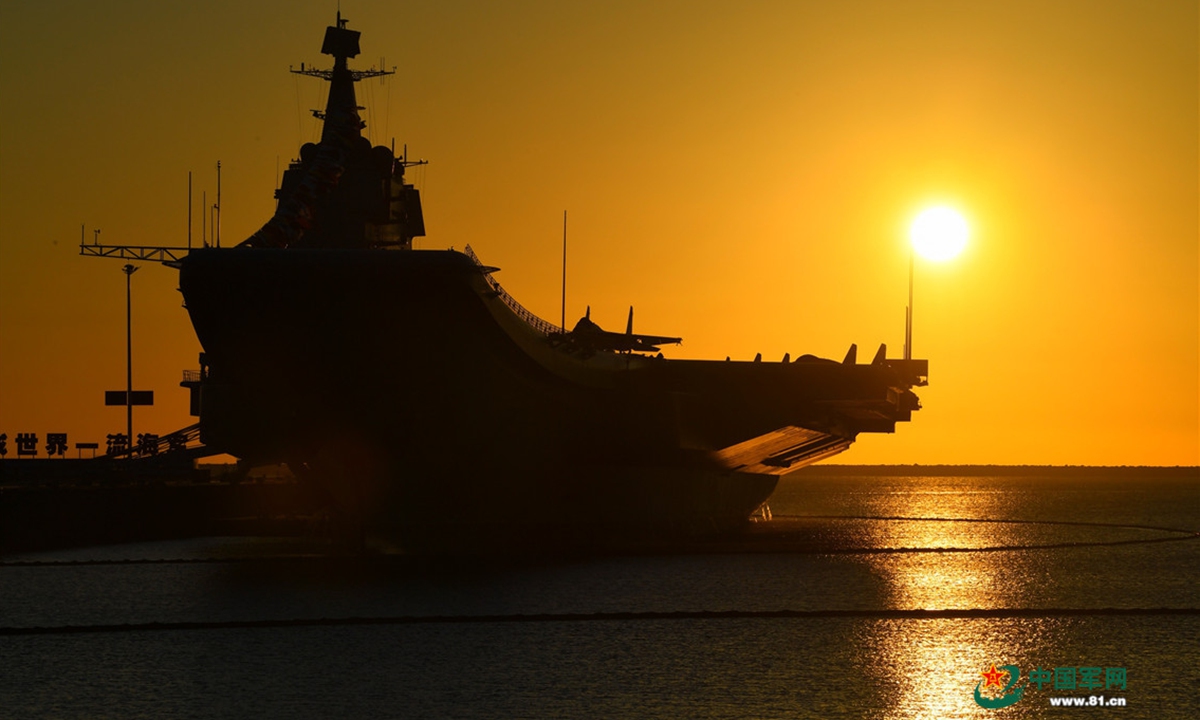
The picture shows aircraft carrier Shandong berths at a naval port in Sanya. China's first domestically-made aircraft carrier Shandong (Hull 17) was officially commissioned to the PLA Navy at a military port in Sanya, South China's Hainan Province, on the afternoon of December 17, 2019, making China one of the few countries in the world that have multiple carriers. Photo:China Military
The Shandong aircraft carrier group of the Chinese People's Liberation Army (PLA) Navy recently wrapped up its first far sea exercises in the West Pacific, in which it collaborated with
the Rocket Force, land-based aviation forces and other surface combat units beyond the first island chain, as more details emerged to refute foreign media claims that Chinese carriers play only a "theatrical" role.
After the month-long far sea combat readiness drills in waters to the east side of the island of Taiwan, the Shandong carrier group recently returned to its home port, the PLA Navy said in a press release on Saturday.
This is the first time the Shandong carrier group has sailed in the West Pacific waters in a systematic and large-scale manner, the PLA Navy said.
Analysts said that the announcement serves as a solid response to a Reuters report, which claimed on Friday that China's aircraft carriers "play a theatrical role but pose little threat yet."
During its recent voyage, the Shandong took part in combat alert patrols and "Joint Sword" exercises encircling the island of Taiwan, and simultaneously carried out combat alert missions, course-oriented practice as well as flight sorties, in addition to joint exercises with
the Rocket Force, land-based aviation forces and other surface combat units beyond the island chain, the press release read.
The PLA Rocket Force operates anti-ship ballistic missiles like the DF-21D and the DF-26 that can target medium-sized and large maritime targets, according to official reports.
A total of four land-based H-6J/K bombers - which are capable of carrying land attack, anti-ship and hypersonic missiles - flew across the Miyako Strait into the West Pacific on April 21 and 22 during the Shandong carrier group's drills there, according to press releases from Japan's Ministry of Defense Joint Staff at the time.
The recently commissioned Type 055 large destroyer Xianyang held an extended exercise across several sea regions with the Type 054A frigate Bayannaoer, China Central Television (CCTV) reported on Saturday.
Many other PLA Navy flotillas carried out exercises in multiple sea regions in the same time period, according to media reports.
This time, the Shandong carrier group consisted of the aircraft carrier Shandong, the Type 055 large destroyer Yan'an, two Type 052D destroyers, two Type 054A frigates and a Type 901 comprehensive replenishment ship, according to photos and videos released with the PLA Navy press release.
More vessels, including nuclear-powered submarines, could also be a part of the group, analysts said.
It shows that the Shandong does not fight alone, but in a comprehensive combat system, a Chinese military expert told the Global Times on Sunday, requesting anonymity.
Aircraft carriers play key roles in the PLA's comprehensive combat system, as they add many more tactical options the PLA would not otherwise have, including pushing maritime and air defense lines further away from the homeland and applying strategic deterrence, the expert said.
It is short-sighted to simply compare the Chinese carriers with their US counterparts, because the whole combat system and the purposes of deployment should also be considered, the expert said.
"In combat, the enemy will have to simultaneously deal with a carrier group with fighter jets and warships with hundreds of missile vertical launch cells and anti-submarine capabilities, as well as land-based and aircraft-based anti-ship ballistic missiles and hypersonic missiles."
The press release from the PLA Navy also said the carrier dealt well with close-in reconnaissance attempts by foreign warplanes and warships.
According to
Japan's Defense Ministry, the Shandong hosted about 620 aircraft sorties in 18 days in the West Pacific, which showed that the capabilities of the Chinese carriers alone are also decent, observers said.
Videos released by the PLA Navy show that some of the sorties were completed at night, widely seen as a very challenging task.
Song Zhongping, a Chinese military expert and TV commentator, told the Global Times that with the exercises, Chinese aircraft carriers are on their way to become even more capable as they accumulate experience.
This not only applies to the two carriers the PLA now has in service, but also more carriers to come, including the country's third carrier, the Fujian, which is equipped with electromagnetic aircraft launch and arrest devices and is much larger than the country's previous two carriers in terms of displacement, observers said.
CCTV reported in late April that China will eventually build more aircraft carriers with more advanced aircraft. The new aircraft could include carrier-based stealth fighter jets, electronic warfare aircraft, early warning aircraft and drones, experts said.
Foreign media are now in a self-contradiction of hyping the "China military threat" theory and the "China aircraft carrier is no threat" theory, and this only exposes their double standards and powerlessness facing China's normal and rightful development, analysts said.




